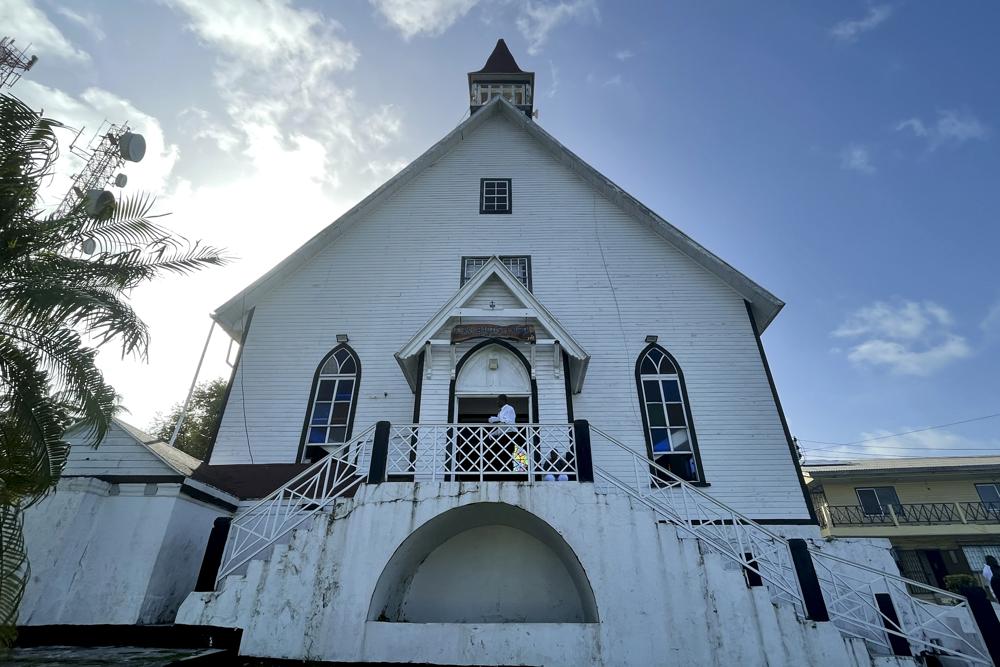A man stands at the entrance of First Baptist Church on Colombia’s San Andres Island on Sunday, Aug. 21, 2022. The church is a symbol of emancipation and a source of pride for the Raizals, the English-speaking, mostly Protestant inhabitants of San Andres and smaller islands that form an archipelago in the western Caribbean. (AP Photo/Luis Andres Henao)
SAN ANDRES, Colombia (AP) — First Baptist Church was born by a tamarind tree perched on a hill overlooking the turquoise waters of the Caribbean.
Under the tree’s shade, First Baptist’s founder taught English-speaking former slaves and their descendants how to read using the Bible. The tree still stands more than 175 years later — even if crooked after surviving devastating hurricanes.
The church is so crucial to the history of the Colombian island of San Andres that detailed record of births and deaths are kept here in crumbling books that date back nearly two centuries.
The “mother church,” as it is often called, is a source of pride for the Raizals, the English-speaking, mostly Protestant inhabitants of San Andres, Providencia and the smaller islands and keys that form an archipelago in the western Caribbean near Nicaragua, about 440 miles (710 kilometers) from the Colombian mainland.
“For a young person like me, it’s finding my roots — it’s good to know where we come from,” said the Rev. Shuanon Hudgson, 26, the church’s associate pastor.
“It’s like Marcus Garvey says,” Hudgson continued: “‘A people without knowledge of their past history, origin and culture is like a tree without roots.’ And this church has been a pillar.”
Under the tree, a stone plaque commemorates the birth of the congregation: “Baptist work was established here by Rev. Phillip Beekman Livingston (Jr.) in 1844.”
Three years later the congregation began to meet nearby under a thatched hut.
It kept growing, and a building made in the style of the large Anglican churches of Jamaica was ordered. First built in the late 19th century in Mobile, Alabama, and then moved to New York City, the white-walled church was disassembled and shipped to the island piece by piece.
Parishioners carried the foundations on their backs from the port to one of the highest points on the island, a neighborhood known as the Hill, said Lastenia Herrera May, the wife of the current lead pastor, the Rev. Ronald Hooker, and the church was dedicated on Feb. 2, 1896.
A mirador more than 100 feet up in the steeple offers some of the best views of San Andres.
Over a century after being claimed by Spain, the island was first settled in the 1630s by English Puritans. It later became an outpost for pirates and today is home to many descendants of Puritans and African slaves, and also large numbers of more recent arrivals from mainland Colombia.
Sharika Crawford, a professor of history at the United States Naval Academy in Annapolis, Maryland, whose research focuses on Colombia and its African-descended peoples, said First Baptist “was the bedrock of the Raizal community” and “the most important social institution” in the archipelago.
From its founding until 1913, she said, its pastors held great authority over the community in shaping islanders’ values and behavior.
“Before the church was formed, the island population lived without a church or religious establishment. Efforts to bring a Catholic priest never materialized,” Crawford said. “Thus, First Baptist Church and its satellite churches across San Andres and Providencia Islands had the advantage over other Christian communities such as the Catholics and Seventh-day Adventists.”
“The church had glorious moments,” Herrera May said. “By the 1900s, thousands had converted.”
Livingston, the founder, first evangelized among enslaved and freed people of San Andres, Crawford said, and the church remains a symbol of the anti-slavery struggle. Each year people from congregations across the islands gather here Aug. 1 to celebrate events commemorating emancipation.
During a recent Sunday service, Lucia Barker, 83, and other women in the choir, clothed in bright pink shirts, sang hymns. Parishioners in wooden pews, illuminated by sunlight from stained-glass windows, swayed, lifted their arms and sang along to songs infused with Calypso beats.
“This church is my life,” Barker said of the sanctuary where she was baptized, married and has worshipped for more than seven decades.
In his homily, Hudgson, the associate pastor, asked congregants to remember the sacrifice of their enslaved ancestors. He called on them to be resilient against adversity, just as the tree and the church, and listed by name and year the many hurricanes that both survived.
“Here we get the knowledge about our land, our history, how we started by this tamarind tree, how we have a church,” choir member Marjeen Martínez said. “It’s very important to maintain our roots alive.”
Associated Press religion coverage receives support through the AP’s collaboration with The Conversation US, with funding from Lilly Endowment Inc.
Copyright 2021 Associated Press. All rights reserved.
Source: https://apnews.com/article/religion-colombia-caribbean-trees-37b8437f63960786a63c083f9b3f4268


